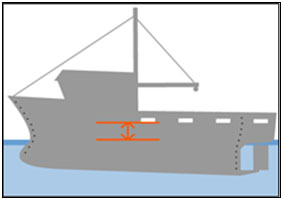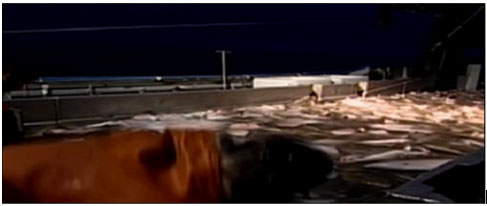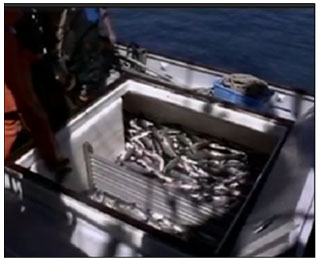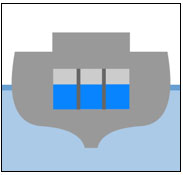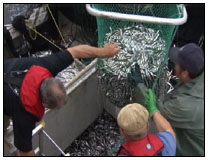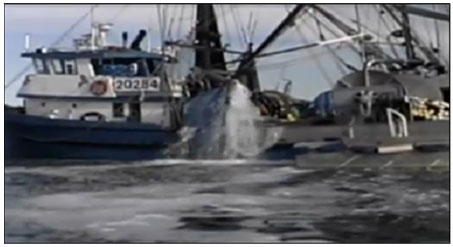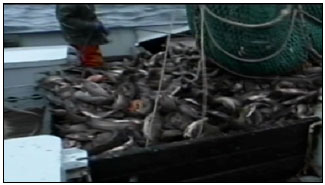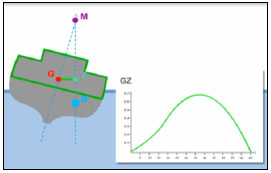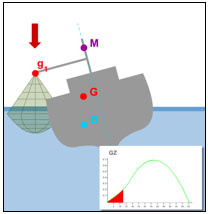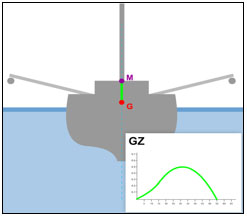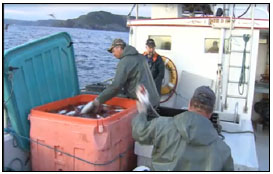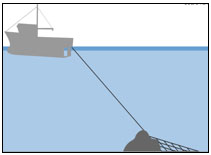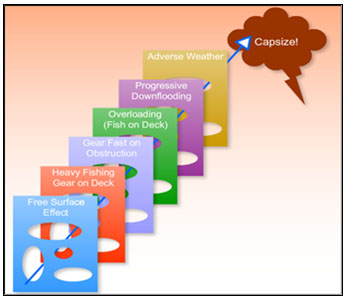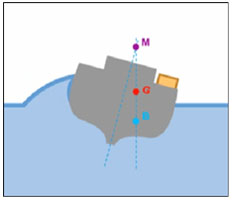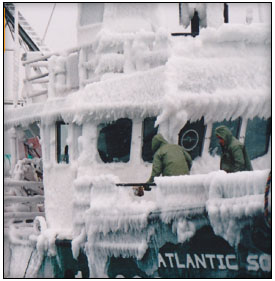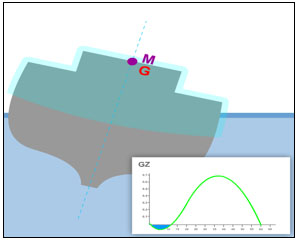The fishing vessel safety regulations came into force on July 13, 2017. The regulations contain new stability requirements for small fishing vessels. Vessels not required to undergo a stability assessment are required to have adequate stability. The guidelines are an aid to fishing vessel owners and operators on how to take preventative measures to maintain their vessel's stability as well as guidance on best operational practices to avoid a swamping or capsizing of their fishing vessel.
If you wish to receive a copy of the guidelines, please submit your request to the marine safety general email inbox at marinesafety-securitemaritime@tc.gc.ca
On this page
- Acknowledgements
- Instructions on the use of these guidelines
- Section 1: Adequate stability and safety checklist
- Section 2: supporting stability and safety information
- Conclusion
Acknowledgements
These guidelines have been produced and developed jointly and under contract with the Canadian Independent Fish Harvesters Federation (CIFHF) and Transport Canada and in consultation with the Canadian Marine Advisory Council (CMAC).
Information in this document is written for personal and public non-commercial use. Transport Canada allows the reproduction in whole or in part, with appropriate credit, provided no changes have been made to the content and it is intended for non-commercial use only.
A written permission from Transport Canada is necessary to reproduce multiple copies of this material, in whole or in part, for the purposes of commercial redistribution. Contact TCcopyright-droitdauteurTC@tc.gc.ca for more information.
Introduction on the use of these guidelines
The Regulations Amending the Small Fishing Vessel Inspection Regulations (Herein after referred to as the Fishing Vessel Safety Regulations), http://laws.justice.gc.ca/eng/regulations/C.R.C.,_c._1486/ came into force on July 13, 2017. The regulations contain new stability requirements for small fishing vessels in Canada. In particular, section 3.45 of the regulations states that "the stability, and, if applicable, the buoyancy and flotation of an existing fishing vessel that is not required to undergo a stability assessment shall be adequate to safely carry out the vessel’s intended operations."
Please note that some fishing vessels are required to have a stability assessment. Reference can be made to Ship Safety Bulletin 03/2017 "Coming into force of phase 1 of the new Fishing Vessel Safety Regulations" www.tc.gc.ca/ssb-bsn/ SSB#03/2017 which outlines which fishing vessels are required to have a stability assessment and which fishing vessels are required to have adequate stability. As such, these guidelines provide a tool to aid fishing vessel owners and operators on how to take preventative measures aimed at maintaining their vessel’s stability as well as to provide guidance on best operational practices to avoid a swamping or capsizing of their fishing vessel.
It is important to be stability safety conscious at all times. No vessel is immune from swamping or capsizing, no matter how stable they are and irrelevant of the fact that they may have operated without incident for years. It is also important to note that each vessel’s configuration and particular operations are different.
These guidelines are presented in two main sections.
Section 1 is the Adequate Stability and Safety Checklist. Put a check in the box for each checklist item which you have verified for your vessel and use the N/A check-box for any checklist item that is not relevant or applicable. An item not checked N/A should meet the intent of the supporting guidelines located in section 2. Please ensure that your review each checklist item.
Section 2 is the Supporting Information for the checklist. As an aid, each checklist item is provided with technical supporting information for each checklist item.
While these guidelines are voluntary, fishing vessel owners and operators are encouraged to use and review them periodically. The use of these guideline should help you better understand the stability of your fishing vessel and whether it is likely to have adequate stability. If you are unsure of how your vessel measures up to any item(s) on this checklist or if you have concerns about the stability of your vessel, you should contact a marine consultant or regional Transport Canada Centre for further assistance.
Note: Adherence to these guidelines and completing the checklist does not guarantee that a stability assessment would not be required for your fishing vessel. These guideline are not a stability assessment nor is it a tool to measure your vessels stability.
Section 1: Adequate stability and safety checklist
1.0 Prevention of downflooding
| Checked | n/a | |
|---|---|---|
| a. All manhole covers are properly secured and the seals are well maintained. | ||
| b. All windows, skylights and accommodation escape scuttles are secured and weathertight to prevent the ingress of water. | ||
| c. All exterior doors are weathertight to prevent the ingress of water. | ||
| d. All through-hull fixtures (inlets, outlets, transducers, etc.) are watertight. | ||
| e. All tank vent pipes, or other hull and deck fixtures and engine room air intakes (ventilators) are of sufficient height. | ||
| f. Hatch coamings and door sills are of sufficient height. | ||
| g. Hatch coaming(s) have a means to be covered and prevent water entry into the vessel. |
2.0 Minimizing free surface effect
| Checked | n/a | |
|---|---|---|
| a. Freeing ports or scuppers (floodgates) are of sufficient size to enable seawater to drain overboard quickly. | ||
| b. Freeing ports are not obstructed in any way while at sea. | ||
| c. All tanks are fitted with baffles and/or subdivisions. | ||
| d. Catch is stowed in suitable containers to prevent free surface movement. | ||
| e. Pen boards are used to secure the stowage of all onboard catch. | ||
| f. Fish pumping or brailing arrangements allow for rapid but controlled dewatering. | ||
| g. During trips, action is taken to minimize free surface effect as a result of changes of onboard fluid levels. |
3.0 Vessel construction & maintenance considerations
| Checked | n/a | |
|---|---|---|
| a. The hull is watertight and not leaking. | ||
| b. The deck is watertight and not leaking. | ||
| c. The vessel is fitted with at least two sound transverse subdivisions (bulkheads). | ||
| d. The superstructure is sound and properly maintained for the area of operation. | ||
| e. All superstructure fixtures are of suitable robust construction for the area of operation. | ||
| f. Underwater fixtures and valves are of suitable material, construction, properly installed, accessible and are well maintained. | ||
| g. All on-board alarm systems, including bilge alarms, are fully operational and tested regularly. | ||
| h. Adequate bilge suctions are installed in each compartment of the vessel. | ||
| i. All bilge suctions are regularly maintained to ensure functionality. | ||
| j. All bilge pumps are fully operational and tested regularly. | ||
| k. Non-return check valves are fitted and fully operational on all overboard discharges. | ||
| l. All fish hold and enclosed deck sump pumps are fully operational and suctions are clear. | ||
| m. Overhead lifting equipment is of suitable construction and is properly installed and maintained. | ||
| n. Overhead riggings and hardware are of suitable construction and are properly installed and maintained. | ||
| o. High points of suspension for towing or handling fishing gear are of suitable construction and are properly installed and maintained. | ||
| p. Paravane stabilizers are of suitable construction and are properly installed and maintained. | ||
| q. Hull mounted anti-roll fins are of suitable construction and are properly installed and maintained. | ||
| r. The anti-roll tank quick release mechanism is tested and fully operational. | ||
| s. Modifications to the vessel or machinery are considered in terms of maintaining sufficient stability. |
4.0 Stability conscious operational practices
| Checked | n/a | |
|---|---|---|
| a. All catch is properly stowed and secured as it comes on board. | ||
| b. Catch that is temporarily stowed on deck is secured from movement. | ||
| c. There is no accumulation over time, of unnecessary weights on board the vessel. | ||
| d. While towing from high points of suspension, the vessel has adequate stability to withstand potential shock loads. | ||
| e. The vessel loads properly and maintains sufficient freeboard for the area of operation, weather conditions and season. | ||
| f. The vessel has good longitudinal trim at all times during fishing operations. | ||
| g. Suitable on-board fishing gear storage arrangements are in place and used regularly. | ||
| h. All valves for cross-connected tank are well maintained and readily accessible. | ||
| i. Exterior access fixtures such as doors, hatch covers, and man-hole covers are kept closed while at sea. | ||
| j. Heavy lifting and towing operations are suspended during adverse weather or icing conditions. | ||
| k. Towing is done as low as possible and directly off the vessel’s stern. | ||
| l. The vessel does not have a permanent list. | ||
| m. If operating during the icing season, appropriate tools and personal protective equipment (PPE) for ice removal are on-board. | ||
| n. If operating during the icing season, measures are taken to maintain sufficient vessel stability. | ||
| o. If operating during the icing season, measures are taken to safely remove accumulated ice. | ||
| p. Changes to the vessels fishing activity are considered in terms of maintaining sufficient stability. |
Section 2: Supporting stability and safety information
Information in this section will aid fishing vessel operators with the completion of section 1 Adequate Stability and Safety Checklist. Section 2 provides practical information on many of the negative stability factors associated with fishing operations, focusing on promoting safer seamanship to prevent capsizing or swamping of your vessel. The information in section 2 is basic in nature and as such, depending upon the circumstances, may or may not apply to your particular operation.
All of the figures in this section were extracted from the Fishing Vessel Stability E-Simulator (FVSS). For further information on fishing vessel stability, this tool is available for free downloading from the web site for the Canadian Council of Professional Fish Harvesters (CCPFH) at: http://www.fishharvesterspecheurs.ca/professional-development/safety/stability-simulator/download
(Courtesy of the Canadian Council of Professional Fish Harvesters).
Note: Explanation of what is meant by the terms watertight and weathertight, within these guidelines:
Watertightness: (ISO degree of watertightness 1)
In practical terms, watertightness refers to the ability of a vessel or any of its fixtures and appliances to keep out water under the head of pressure to which it is exposed. No water should enter a vessel for example, through the hull. (One standard for determining whether your deck appliances are watertight and fit for their intended purpose, is ISO standard 12216: Small craft – Windows, portlights, hatches, deadlights and doors – Strength and watertightness requirements.)
Weathertightness: (ISO degree of watertightness 2 to 4)
Weathertightness, in practical terms, means that in any sea condition water will not penetrate into the vessel through the appliance. With a weathertight door for example, tested with a normal garden hose a few drops may penetrate after being exposed for a few minutes. To avoid downflooding, all appliances above the deck (i.e., deck hatches, windows and doors) should be designed and fitted to prevent the substantial ingress of water when closed. These appliances, on fishing vessels, should be able to provide protection against the ingress of water when subject to temporary immersion. (One standard for determining whether your deck appliances are weathertight and fit for their intended purpose, is ISO standard 12216: Small craft – Windows, portlights, hatches, deadlights and doors – Strength and watertightness requirements.)
1.0 Prevention of downflooding
Checklist items (a) to (d): Cumulative downflooding.
- Downflooding refers to the unwanted entry of water into the vessel. Downflooding can occur in varying degrees, ranging from sudden catastrophic water entry, to slow leaks around fixtures, which can have a serious cumulative effect. Please refer to Figure 1.0.
- Keeping water out of a vessel is of paramount importance from a stability perspective. Unwanted water entry reduces stability in several ways:
- The added weight will reduce freeboard (Please refer to Figure 1.1).
- Water will accumulate on the low side of a listed vessel, increasing the list.
- Another problem associated with downflooding is that free surface effect further reduces stability as water sloshes from side to side. Its negative effect on stability is often underestimated. Free surface effect refers to the reduction of a vessel’s stability due to a virtual rise in the vessel’s center of gravity, caused by the uncontrolled movement of fluid or fluid-like cargo on board a vessel. This negative effect on stability is in addition to the actual physical change in the position of the center of gravity of the fluid in the tank. Loss of stability, due to free surface effect, can be substantial and has contributed to the capsizing of many fishing vessels in the past.
- The water may also make some types of on-board catch become more fluid-like, compounding the loss of stability due to free surface effect.
- The reduction in freeboard due to the added weight or increased list, rapidly reduces all reserves of buoyancy and remaining overall stability.
Figure 1.1:
Freeboard refers to the distance from the present waterline to the deck edge, at its lowest point. The amount of freeboard that a vessel has, directly impacts its statical stability reserves.
(Courtesy of the Canadian Council of Professional Fish Harvesters).
Checklist items (e) to (g): Critical downflooding points:
- Critical downflooding points are those places identified on board a vessel through which water will first gain access in the event that the vessel is listed or heeled to an angle, for whatever reason.
- All vessels have critical downflooding points. They are clearly identified for those vessels with stability booklets, but in all cases they should be identified and measures taken to reduce the risk of downflooding.
- In its upright condition and in calm seas, most vessels could operate safely with relatively low critical downflooding points. However, it’s important to remember that during operational conditions, any vessel can heel over, and potentially cause seawater to enter the vessel through these critical downflooding points. If seawater enters through these downflooding points, all reserves of stability are lost and the vessel could capsize.
- A close inspection of your vessel will reveal where its potential critical downflooding points are. Typically, a door sill, hatch coamings or vent intakes will be identified as the first point of entry of water, should the vessel be inclined to a large angle.
- Secure all watertight openings (doors, hatch covers, windows, etc.) in the hull and deck structure when not in use, to prevent downflooding. All watertight openings must be inspected regularly to ensure their tightness.
2.0 Minimizing free surface effect
Checklist items (a) & (b): Adequate sized and unobstructed freeing ports:
- Freeing ports are sometimes referred to as scuppers or floodgates. They are the openings in the bulwarks that allow the water to escape from the vessel’s deck. Please refer to Figure 2.0.
- Freeing ports that are undersized or blocked could allow water that is retained on deck to reduce stability:
- The added weight will raise the vessels center of gravity (G) and reduce the freeboard, both of which causes a reduction in the stability reserves.
- The added free surface effect (FSE) will further reduce stability, as the retained water is free to move from side to side. Please refer to Figure 2.1. Free flowing water will gather on the low side of a listed or heeled vessel, exposing it to the danger of capsizing.
Figure 2.0:
Freeing ports must be kept clear at all times to allow water to escape from the deck
(Courtesy of the Canadian Council of Professional Fish Harvesters).
Figure 2.1:
The retention of water on deck can greatly degrade stability due to FSE.
(Courtesy of the Canadian Council of Professional Fish Harvesters).
- Water trapped on deck will increase the risk of cumulative downflooding through deck appliances or fixtures not usually exposed to large volumes of water.
- Items on deck such as fishing gear and catch may shift rapidly, due to the added forces of the trapped water, and negatively impact the vessels stability.
Checklist items (c) to (e): Potential transverse movement of on-board liquids and catch:
- The rapid reduction of stability due to the negative forces of free surface effect has been cited as the leading cause of the capsizing of many fishing vessels.
-
A vessel’s reduction in stability due to free surface effect is cumulative for all on-board fluids or fluid like cargo at any given time.
Figure 2.2.
Seals around man-hole covers are amongst the many items associated with closing appliances that must be checked regularly and properly maintained. (Courtesy of the Canadian Council of Professional Fish Harvesters). - For a uniformly shaped tank, the reduction of stability due to free surface effect will be the same at all levels of fill, unless the tank is empty or completely full. For a tank with angled or curved sides, it will be greatest at fluid a depth which corresponds to its maximum breadth. In addition, when a vessel with a full tank is heeled, the liquid within the tanks acts like a solid mass. Its G, being the centre of its volume, remains constant and therefore does not cause any change in the vessel’s G as the vessel is heeled. When a vessel with a partially-filled tank is heeled however, the liquid will seek to remain parallel with the waterline. In these cases, in addition to the virtual rise of the G, caused by the free surface effect, the G of the liquid, being the centre of its volume, will physically move to the geometrical center of the liquid and can also have a considerable negative effect upon the vessel’s stability. The effect is similar to that caused by adding weight on deck.
- The breadth of a tank or fish hold compartment is a major contributor to free surface effect. Reducing the tank or compartment breadth, with baffles or pen boards for example, is essential in reducing free surface effect. Please refer to Figure 2.2.
- As an example, for a typical 16.76m (55 foot) (80t) fishing vessel, with a fish hold of (20 foot. x 18foot. x 6 foot.) (6.1m x 5.5m x 1.8m) used to fish capelin and herring, the following effect on stability due to free surface effect can be calculated:
- With two longitudinal (lengthways) runs of pen boards, used to divide the fish hold into three longitudinal compartments, and with the hold partially filled with capelin, the initial stability will be reduced by about 0.115 meters (@4.5 inches) due to free surface effect (i.e.: There will be a virtual rise of G by that amount).
- With no pen boards used at all, the reduction in stability due to free surface effect would amount to 1.032 meters (@3.4 feet), nine times more than with pen boards.
- The amount of reduction in stability numbers, in this example, refers to the virtual rise in the vessel’s G, due to the free surface effect of the catch, in each case. A virtual rise of G of over 1 meter, with the addition of any external forces, such as wind or sea, could lead to the capsizing of the vessel.
- Baffles in all on-board tanks, such as fuel and fresh water tanks minimize the free surface effect and helps to minimize the reduction of stability. Please refer to Figure 2.3.
- Large fish tanks or holds should be compartmentalized or penned off to reduce the effects of liquids moving from side to side.
Figure 2.3:
Subdivisions in all on-board tanks are vital to reducing the loss of stability reserves due to free surface effect.
(Courtesy of the Canadian Council of Professional Fish Harvesters).
Checklist items (f): Effective dewatering during fish pumping or brailing operations:
- Large volumes of water are retained as catch are either pumped or brailed on board.
- An effective means, such as a dewatering box, screen or pumping elbow must be used to remove the water before the catch enters the vessel, to minimize free surface effect. Please refer to Figure 2.4.
Figure 2.4:
Brailed fish need to drain before being taken on board.
(Courtesy of the Canadian Council of Professional Fish Harvesters).
- Equally important, the water must be re-directed back overboard. Please refer to Figure 2.5. Given the rapid rate at which catch (and water) is loaded using a fish pump, if dewatering is not effective, stop the operation immediately, until the situation is remedied, in order to prevent excessive water from entering the vessel, with subsequent loss of stability due to free surface effect and possibly contributing to capsizing.
Figure 2.5:
On-board retention of water should be minimized during fish pumping dewatering operations.
(Courtesy of the Canadian Council of Professional Fish Harvesters).
- When brailing catch on board, having the catch ‘dried-up’ properly at all times, minimizes water retention.
Checklist items (g): Mitigating measures for increased free surface effect during the voyage:
- The vessel’s stability is constantly changing during the voyage, due to several operational factors, such as, the on-going consumption of fuel and fresh water, melting of ice and/or the use of bait, retrieving or setting of fishing gear, loading of the catch, towing fishing gear, lifting from high points of suspension and all on-board movement of weights as per operational requirements. All possible measures must be taken throughout the fishing trip to minimize the loss of stability. Minimizing all on-board losses of stability due to free surface effect is important.
- As consumables such as fuel, fresh water, bait, and ice are used and catch is loaded, the resultant effect on the vessels stability due to changes in free surface effect is usually negative. Operational measures to minimize this loss include:
- Use the minimum number of tanks only, leaving as many as possible either full or empty.
- As ice melts, engage the bilge pumps frequently to keep water out of the bilges and fish hold spaces.
- Fuel tank levels should be managed properly to limit the free surface effect.
- The loading of catch with fluid-like characteristics, such as herring, capelin, pilchards and sea cumbers, to name just a few, will normally increase the total on-board free surface effect, degrading the overall stability of the vessel. The proper and effective use of compartment subdivisions, such as pen boards, can greatly minimize the loss of stability.
- Minimize the retention of catch on deck to as short a period as possible. Please refer to Figure 2.6.
Figure 2.6:
Minimize the amount of time that the catch is retained on deck.
(Courtesy of the Canadian Council of Professional Fish Harvesters).
3.0 Vessel construction & maintenance considerations
Checklist item (a): The hull is watertight and not leaking.
The hull of a fishing vessel should be watertight under continuous immersion conditions and not leaking. For example, seawater should not penetrate through wood planked or FRP hulls or through any hull fittings such as thru-hull connections, ground plate bolts, transducers, sonar pipes, keel coolers , or propeller shaft and rudder stock seals, at the depth of water to which they will be subjected. The interior of the hull should also have suitable watertight bulkheads to prevent the passage of water from one compartment to the other to prevent the loss of reserve buoyancy in the event of flooding. Proper construction and maintenance of the vessel is very important.
Checklist item (b): The deck is watertight and not leaking into interior spaces of the vessel.
The deck structure should be of suitable construction, watertight and not leaking. It should meet the requirements of ISO 12212 standard, “degree of watertightness 2", which means that the deck should provide protection against the effects of temporary immersion in water in the worst anticipated operating conditions. Freeing ports or scuppers should be provided for clearing water off the deck. Deck coamings should be of adequate height and strength and should be provided with efficient and rapid means of closing to help prevent water from leaking into the interior spaces of the vessel. Proper construction and maintenance of the vessel is important.
Checklist items (c): Transverse bulkheads (subdivisions):
- Transverse (crossways) bulkheads in a fishing vessel should provide three essential functions:
- To subdivide the vessel into watertight compartments in the case of flooding.
- To provide strength to the hull, to cope with various stresses while at sea.
- To provide a barrier against the rapid spread of fire (especially so for engine room bulkheads)
- The location of bulkheads in small fishing vessels is critically important to maintaining proper trim during some conditions of load. Please refer to Figure 3.0.
Figure 3.0:
Longitudinal trim refers to the difference between the forward draft and the after draft at a given time.
(Courtesy of the Canadian Council of Professional Fish Harvesters).
Checklist items (d) & (e): Contribution of superstructures and their fixtures to overall stability:
- Wheelhouses and deckhouses provide added reserve buoyancy and overall stability to a fishing vessel; provided that water does not leak into the vessel at some location and that they do not fail under stress from the forces of the sea. Please refer to Figure 3.1.
- All deckhouses must be adequately secured to the deck with appropriate hardware (bolts) attached in a proper manner.
- Exterior sheeting materials must be checked for deterioration (rot or rust) as well as delaminating, as appropriate, and problem areas addressed.
Figure 3.1:
Reserve buoyancy refers to the total volume of all enclosed watertight spaces above the waterline. Although not providing buoyancy in the upright condition, having enough reserve buoyancy is essential when the vessel becomes heeled or listed.
(Courtesy of the Canadian Council of Professional Fish Harvesters).
- All windows and exterior doors must be of suitable strength and properly installed for their intended purpose, with regard to the vessel’s area of operation.
- Other potential weak points, such as stove pipes or galley vents should be examined and repaired if found to be defective.
Checklist items (f): Underwater fixtures and valves are of suitable material and construction, properly installed, accessible and are well maintained.
- For vessels operating in salt water, pipe fittings of dissimilar metals, such as galvanized steel and bronze must not be connected together. In the presence of salt water, which is a catalyst, galvanic corrosion will destroy the metal of less nobility, in this case the galvanized pipe. This will occur in a relatively short period of time and the pipe connection will fail allowing seawater to flood the vessel.
- When joining dissimilar metals always use a short section of high grade marine hose, connected with proper hose ends and stainless steel clamps.
- Sacrificial zinc or aluminum anodes should be attached when dissimilar metals are used in other underwater applications such as on a steel skeg or rudder as well as internally in the cooling system of a marine diesel engine. These anodes must be checked and replaced periodically.
- Check to see if you have sufficient access from your engine compartment to thru-hull valves such as seawater intakes and overboard discharges. Good access should be available in case it is necessary to close one of these valves in an emergency such as a burst pipe. If access is restricted in your machinery space, consider installing extended spindles so that critical valves can be closed rapidly.
Checklist items (g): All on-board alarm systems, including bilge alarms, are fully operational and tested regularly:
- Several alarm systems can be found on-board of a small fishing vessel, all of which provide an important function and should be checked periodically. Some considerations and things to look for when checking your alarm systems include:
- High water bilge alarm sensors should be located in each compartment of the vessel and provide an audible and visual alarm at the vessel operating station.
- The activation of a bilge alarm warrants immediate attention. Pumps should be engaged to remove the water.
- The source of the water, if unknown and not associated with normal operations, must be determined and rectified.
- The bilge alarm must be functional at all times and not disconnected under any circumstance.
- The continued occurrence of false activations must be remedied to avoid potential complacency and dismissal in the event of a real emergency. In many cases, replacement of a bilge alarm float or vacuum canister may be required, while in others, their permanent relocation to a more suitable position, in the bilge, might be the best solution.
Checklist items (h) to (l): Essential function of bilge and other pumping arrangements:
- Depending on the size of the vessel, the primary functions of pumping arrangements on fishing vessels include:
- To remove reasonable amounts of seawater from the interior of the vessel.
- To provide seawater for fire-fighting.
- To allow for the loading, discharging and transfer of ballast water.
- To meet operational requirements. (For example, wash down and sanitation systems).
- To provide water to RSW systems.
- Each compartment should have at least one bilge suction or electric bilge pump.
- All bilge pumps should be tested regularly.
- The vessel’s bilge should be kept as clean as possible at all times. Items such as wood chips, fibreglass material or grease are common and can often wash down from inaccessible places while at sea, clogging bilge suctions.
- If your vessel is fitted with an RSW or Live Well system, check to make sure that it is correctly installed and that suitable materials have been used with regard to all plumbing involved, including the thru hull inlets. Also check to see that the pumps or piping are not leaking and or corroding. Repair or replace defective parts as necessary. RSW systems pump large volumes of water. If a pipe or tank breaks or fractures for any reason, water would rapidly enter other compartments of the vessel, negatively affecting its stability and could contribute to its capsizing.
- Back up bilge pumps, using separate sources of power is recommended. Manual, electric, hydraulic or belt driven are four common types found on board small fishing vessels. (Each potentially having multiple sources of power).
- All valves should be clearly labelled, indicating their purpose. (To which compartment it connects).
- Valves not normally used should be operated periodically and lubricated.
- Bilge suctions (foot-valves or strum-boxes) must be checked and cleaned regularly as required.
- Non-return check valves on bilge suctions must be operational and free from debris.
- All bilge suction access plates should always be left accessible if possible, in the event of an emergency.
- All overboard discharges should be fitted with non-return check valves, to protect against downflooding in the event that they become submerged, should the vessel be heeled or listed.
- Sumps in the fish hold or main deck area must be checked regularly to ensure that suctions are free of debris and fully operational. The inability to rapidly remove water from fish holds or totally enclosed main deck areas, can have severe negative consequences to your vessels stability.
- Wash down hoses should always be removed from the fish hold after use, to avoid unintentional flooding due to siphoning (gravity flow) of water, through the pump, after it has been turned off.
Note: Bilge pumping systems on fishing vessels are not designed or intended to save a vessel from the entry of extreme amounts of seawater, i.e. flooding of the vessel due to swamping and or serious rupture of the hull.
Checklist items (m)(n) & (o): Operational concerns when using high points of suspension:
- Many types of fishing operations require relatively heavy lifting while at sea. Lifting weights using on-board booms, cranes or derricks can be potentially hazardous. As weights are lifted, the G of the load acts through the point of suspension. It’s the same as having the entire weight located at that point, subsequently, the vessels G is also raised and shifted to the low side, reducing the vessels overall stability. While the safety of those working around such operations is of paramount concern and necessary precautions must be taken, it also presents potential serious problems from a stability perspective. Please refer to Figure 3.2.
- During a lifting operation, should a guy rope (stay), block, shackle, connecting point or any other fixture break, the transverse forces of the lift could cause the load to swing instantly outboard and rapidly capsize the vessel.
- While trawling, for example, should one towing point fail, it would concentrate all forces from the strain of the gear onto one side of the vessel.
Figure 3.2:
When lifting or towing from a high point of suspension the total weight or force acts through that point and reduces the vessel’s stability.
(Courtesy of the Canadian Council of Professional Fish Harvesters).
- All overhead fixtures must be of suitable construction and must also be properly installed and maintained for their intended purpose. They should be checked and tested regularly for deterioration.
- Poly ropes are particularly susceptible to deterioration from the sun (UV rays). Depending on the type of rope used, this can occur in a relatively short period of time. Regular replacement of all overhead ropes is recommended.
- Wooden blocks tend to be susceptible to dry rot. They should be checked and coated with clear varnish or similar protectorate so as not to mask defects.
- Points of suspension for towing operations must be of suitable construction, as well as properly installed and maintained for their intended purpose. In addition, the strength of towing points can change over time due to metal fatigue. Regular inspections of all points and maintenance of any areas of concern is recommended.
- Minimize heavy lifting operations as much as possible in large swells or heavy seas.
Checklist items (p): Stability considerations for paravane roll-reduction systems:
Note: Paravane or other roll-reduction systems are not subject to inspection or design approval by Transport Canada. The hull structure and watertight integrity must not be compromised if they are installed.
- The devices should have operating instructions that explain the operating limits, including details on when and how the device should be used safely.
- In some circumstances, an anti-roll device can hide a chronic stability deficiency and provide a false sense of safety. A malfunction of the device may also create an immediate stability risk.
- Reference can be made to Transport Canada, Ship Safety Bulletin 15/2000. “The use of roll dampening paravane systems (paravane stabilizers)” for further information.
- Paravane roll dampening systems, commonly known as paravane stabilizers are used for reducing or slowing down the rolling motion of the vessel, subsequently reducing crew fatigue and enhancing both the comfort level as well as the workplace safety of the crew. They do not improve the stability of the vessel, in fact the opposite is true. Extreme caution should be used if such units are fitted to your fishing vessel.
- The addition of any anti-roll system, except bilge keels, would be a major modification and should only be undertaken after the vessel’s stability has been assessed, as they usually reduce the vessel’s reserves of stability. A system of paravane stabilizers reduces its reserves of statical stability because of all the added weight relatively high up in the vessel. Once fitted, on a vessel, the outriggers should be lowered to the operational position while at sea, even if the paravanes are not deployed. This improves the vessel’s stability because, in the operational position, it lowers the center of gravity. Please refer to Figure 3.3
- Paravane stabilizers present a potential risk to the vessels stability due to the introduction of large capsizing forces, resulting from:
- The loss of one paravane (fish).
- Failure of a fixture or rigging, resulting in the loss an outrigger boom.
- Failure of an outrigger hinge apparatus, or fracture of the outrigger itself.
- One paravane becoming entangled in fishing gear or other obstruction.
- If operating in icing conditions, the extra booms and riggings increase potential ice accretion area.
- There are personal and vessel safety hazards associated with one paravane ‘broaching’ or breaking the surface of the water while in heavy sea conditions. Similarly if a stabilizer (outrigger) should dip into a wave while the vessel is steaming, it could easily fracture.
- Potential vertical and horizontal movement of the outrigger boom must be minimized by appropriate placement of riggings, in line with the outrigger configuration.
- All associated riggings, hardware and mounting point fixtures should be checked regularly for deterioration and fatigue.
Figure 3.3:
Paravane stabilizers use the forces of resistance created by the paravanes (fish) to reduce the roll, however their installation and operation actually reduces the statical stability reserves of the vessel.
(Courtesy of the Canadian Council of Professional Fish Harvesters).
Checklist items (q): Stability considerations for hull mounted fin roll-reduction systems:
- Reference can be made to Transport Canada, Ship Safety Bulletin 04/2010 “Fishing vessel safety. Hinged fins as anti-roll devices” for further information.
- Hull mounted anti-roll fins may provide a more comfortable working platform by reducing the rolling motion, but they may not improve a vessel’s stability.
- From a stability perspective, hull mounted fins present some potential risk:
- If the fin hits something while steaming, such as ice, the hull could be damaged and rapid flooding might occur.
- In icing conditions, ice build-up could occur reducing overall stability and contribute to a heavy list.
- Downward forces due to fishing gear entanglement into a fin or hinge apparatus could cause the vessel to list to that side, submerging the entanglement, making it difficult and dangerous to remedy. With a severe entanglement it could contribute to capsizing.
- In the event that one hull mounted fin is lost or damaged and inoperable, the handling characteristics of the vessel could change significantly, especially in heavy seas. Please refer to Figure 3.4.
Hull mounted hinged fins require regular inspections for signs of fatigue as well as potential hull damage.
(Courtesy of the Canadian Council of Professional Fish Harvesters).
- When docked or docking, hinged fins as well as their mounting fixtures and the hull itself can be susceptible to damage because they extend out past the body of the hull. Appropriate fenders must be available and used at all times.
- The fins and all associated mounting fixtures as well as the hull in the area where they are mounted, should be checked regularly for signs of fatigue or damage.
Checklist items (r): Stability considerations for anti-roll tank roll-reduction systems:
- Reference can be made to Transport Canada, Ship Safety Bulletin 01/2005 “The use of passive anti-rolling tanks (ART) on small fishing vessels” for further information.
- Vessels fitted with an anti-roll tank (ART) will be required to undergo a stability assessment.
- Not all vessels are suitable for anti-roll tank installations. In general ART’s are suitable for vessels with an uncomfortable short roll period that makes working on the vessel difficult and potentially dangerous for its crewmembers. To make a vessel’s rolling motion more comfortable an ART effectively slows down the vessel’s roll. This slower roll comes at the cost of reducing the vessel’s stability. A well designed vessel will have a moderate rolling motion and still be safe. Anti-roll tanks are very specific devices and if improperly installed or misused can result in capsizing.
- Anti-roll tanks use the large free surface forces created by the movement of fluid in a tank, to dampen the roll of a vessel. Should these forces become synchronized with the roll of the vessel, it could rapidly lead to capsizing.
- The quick release valve and its accompanying wheelhouse switch should be checked and tested regularly. Placards indicating its location and purpose should be posted so that the person on watch can act immediately. Please refer to Figure 3.5.
- Water that is released should not be retained on a deck. Check that no obstructions exist.
It is essential that all crew members understand the importance, purpose and operation of the dump valve on an ART. (Courtesy of the Canadian Council of Professional Fish Harvesters).
- In freezing or near-freezing conditions the anti-roll tank should not be used.
- Anti-roll tanks and the fluid add considerable weight, usually in an elevated position in a vessel, greatly reducing its reserves of stability. In addition, the forces exerted directly onto the vessel, during their roll-dampening operation, can stress mounting brackets as well as the vessel’s structure itself. Regular checks for signs of fatigue should be undertaken.
- Anti-roll tanks should be checked regularly for signs of damage or leakage.
- If a vessel has to make a rapid turn to avoid a danger, the fluid in an anti-roll tank will move to the opposite side. This will contribute to the heel of the vessel.
Checklist item (s): Modifications to the vessel or machinery in terms of maintaining sufficient stability.
- Reference can be made to Transport Canada, Ship Safety Bulletin 01/2008 “Fishing vessel safety record of modifications” for further information.
- Modifications to the vessel’s hull, its deck structure or on-board fishing equipment may change its stability characteristics and subsequently its performance at sea. Vessel modifications can change the weight of the vessel, the location of its center of gravity, its’ freeboard and its’ reserve buoyancy, all of which can have a significant negative effect on the reserves of stability of the fishing vessel.
Note: For a list of typical fishing vessel modifications, as well as the potential effect that each could have on its stability, refer to the “Information Guide to Fishing Vessel Modifications and/or Change of Activity”.
4.0 Stability Conscious Operational Practices
Checklist items (a) & (b): Catch stowage arrangements:
- Catch that is temporarily stowed on the deck raises a vessel’s center of gravity, reducing its overall stability and can contribute to a list if it is not stowed evenly. A list also reduces a vessel’s overall reserves of stability.
- Catch that is temporarily placed on the deck should be secured from movement. A system of pens, boxes or other storage units is common. Proper storage minimizes free surface effect and the risk of having the freeing ports inadvertently blocked. It also minimizes the risk of listing the vessel.
- A means should be in place to secure boxes or containers to the vessel at all times, to prevent movement. Please refer to Figure 4.0.
Figure 4.0:
Containers used to temporarily stow catch on deck must be secured from movement.
(Courtesy of the Canadian Council of Professional Fish Harvesters).
Checklist items (c): Cumulative dangers of weight creep:
- The phrase ‘weight creep’ refers to the on-board accumulation of weights over time. Things such as machinery parts, spare fishing gear, personal effects etc., tend to accumulate on board a vessel over time. This added weight, especially on smaller vessels, can negatively impact stability reserves, because it usually raises the center of gravity and it reduces freeboard.
- Periodically, a general check of everything on board will minimize the amount of unnecessary weight and in the meantime it will serve as a reminder of what’s available.
- It is a good practice to keep an on-going list of all spare parts along with their on-board location, and remove all unnecessary items from the deck of the vessel.
- Changing to heavier fishing gear such as a bigger seine or more pots can also have a significant negative effect on a vessel’s stability.
Checklist items (d): Allowances for shock loads:
- Towing fishing gear from high points of suspension can present unique stability challenges, including:
- The forces associated with towing, act through the high point of suspension aboard the vessel. It is the same as adding that amount of weight at that location. This in-effect, raises the center of gravity of the vessel, reduces freeboard as well as the vessel’s overall reserves of stability.
- As a fishing vessel rolls due to the motion of the sea, at the same time that is it towing fishing gear, the forces acting through the point of suspension shifts somewhat from side to side, and could contribute to the capsizing of the vessel. These dynamical forces are referred to as shock loads. Additionally, if one towing wire breaks, this could also contribute to the capsizing of the vessel, especially if on-board gear, catch or other weights were to rapidly shift to one side of the vessel.
- If the towed fishing gear becomes fast upon an obstruction, coupled with sea conditions, the shock loads exerted could seriously impact the stability of the vessel. Please refer to Figure 4.1.
- During towing operations, ensure that measures are taken to maximize the vessel’s reserves of stability, including:
- If practicable, use the lowest towing point available.
- Use the minimum number of tanks only, leaving as many as possible either full or empty.
- Store catch into the fish hold as quickly as possible.
- Ensure the freeing ports are free at all times. Please refer to Figure 4.2.
- Secure all loose gear and other weights susceptible to movement.
- Lower all on-board weights, such as booms and on board fishing gear, as much as possible.
- Keep bilges and fish holds pumped dry at all times.
Figure 4.1:
Shock loads being applied to a vessel while towing in heavy seas or if the gear hooks onto an obstruction can have a serious negative impact on the vessel’s reserves of stability.
(Courtesy of the Canadian Council of Professional Fish Harvesters).
Figure 4.2:
Water trapped on deck, due to blocked freeing ports, can have a significant detrimental effect of a vessel’s stability.
(Courtesy of the Canadian Council of Professional Fish Harvesters).
Checklist items (e) & (f): Appropriate loading characteristics:
- Freeboard directly contributes to a vessel’s reserve stability.
- Always have adequate freeboard for the area and type of operation, as well as the current and expected (forecasted) weather and sea conditions.
- Longitudinal trim directly impacts a vessel’s stability. A vessel trimmed heavily by the stern for example, will have reduced freeboard aft and as such will submerge its deck at smaller angles of heel as compared to one with the same load in good trim.
- Measures may need to be taken to ensure that the vessel is operating with favourable trim at all times. Depending upon circumstances, these may include:
- Using pen boards to subdivide the fish hold so that the load is carried further forward (fwd) (or aft).
- Keeping aft (or fwd) fuel tanks empty during certain fishing operations.
- Filling fwd (or aft) ballast tanks appropriately.
- In cases where the vessel trims badly at all times when loaded, with the advice of a naval architect, consideration may need to be given to undertaking a vessel improvement modification, such as altering the position of the bulkheads or adding a stern buoyancy tank.
Note: For a list of typical fishing vessel modifications, as well as the potential effect that each could have on its stability, refer to the “Information Guide to Fishing Vessel Modifications and/or Change of Activity”.
Checklist items (g): On-board stowage of fishing gear:
- In most documented cases, there are many contributing factors that led to a vessel capsizing, with the most obvious incident being the final trigger. Please refer to Figure 4.3. One such factor is quite often the rapid and uncontrollable shifting of on-board fishing gear, equipment or other weights.
Figure 4.3:
The cause of many fishing vessel capsizes is often attributed to the last, most apparent reason, while in reality, most have several contributing factors.
(Courtesy of the Canadian Council of Professional Fish Harvesters).
- Depending upon the type of operation, mitigating measures to minimize the possible movement of on-board fishing gear or equipment might include:
- Securing arrangements for pots, as they are stacked or stowed on deck.
- A suitable pen or bin for stowage of rope or gear as it is retrieved.
- The use of storage rollers or reels for fishing gear and spare gear.
- Deck mounted longitudinal ribs, in the seine storage area to minimize the shifting of the seine, should the vessel be heavily listed or heeled.
Checklist items (h): Operational considerations for cross-connected tanks:
- When two or more tanks, usually fuel tanks, are connected such that both feed into one engine supply line, they are commonly referred to as being cross-connected. While each tank would usually be fitted with its own shut-off valve, it is common practice to leave both open so that fuel is consumed from each tank evenly. The fuel tanks in many fishing vessels are usually configured this way for several reasons, including for convenience of operation as well as to minimize the number of supply lines passing through potentially sensitive areas such as cargo spaces.
- In the event that the vessel is listed or heeled, especially for an extended period of time, the fuel will gravity over to the low side through the cross connection. This weight shift will compound the problem and make it more difficult for the vessel to recover.
- From a stability perspective, it is preferable to use one tank at a time and leave the cross connection closed at all times. If it is not always operationally practical to do so, arrangements should be in place such that it is available as an option if required.
- All tank supply and return lines should be fitted with easily accessible valves that are checked, lubricated and operated regularly.
- If valves are not easily accessible due to operational constraints, consideration should be given to using ball-valves with emergency manual shut-off wires, led through blocks, to an easily accessible location.
Checklist items (i): At-sea precautions against downflooding:
- The watertight integrity of the vessel’s, hull and its superstructure is essential to the survival of the vessel. As previously defined, the total volume of all of the enclosed spaces within a vessel makes up its reserve buoyancy, which contributes significantly to its overall reserves of stability.
- All openings in the vessel and its superstructure are potential sources of downflooding, should the vessel be severely listed or heeled for whatever reason.
- While it is obviously necessary to use exterior doors, hatches and man hole covers for operational needs, it is good operational practice to ensure that all of these fixtures remain closed at all times, when not in immediate use. The placement of appropriate placards indicating this recommended best-practice would serve as a good memory aid.
Checklist items (j) & (k): At-sea precautions against unpredictable dynamical forces:
- As discussed previously, many types of fishing operations require relatively heavy lifting, while at sea. As weights are lifted, the center of gravity of the load acts through the point of suspension. It’s the same as having the entire weight located at that point. Towing fishing gear has a similar effect on stability, with the entire forces acting through the towing point, along with all relevant shock loads. During lifting and towing operations, the vessel’s reserves of stability are negatively impacted.
- Mitigating measures to minimize the potential negative impact on stability include:
- If fishing in less than favourable conditions, depending on your particular type of operation, adjust fishing practices to reduce the loads. This might include:
- Fishing on known ‘good bottom’, if practicable, to minimize the risk of hooking-on.
- Using shorter towing times to reduce catch amounts.
- Lifting smaller amounts of catch at a time to reduce the forces.
- Alter towing positions to as low as possible off the stern (if practicable).
- Adjusting handling practices to get the catch stowed below deck quicker.
- As an operational norm, always be prepared to suspend fishing operations when the weather and seas changes and becomes worse, irrelevant of what other vessels may be doing.
- The towing direction in adverse sea conditions can have a huge effect on the vessel’s stability:
- Turning while towing for example, may cause the vessel to ship large amounts of water as the quarter submerges due to the force of the gear coupled with the sea and swell.
- Towing ‘with the wind and sea’ may be the most ‘comfortable direction’ but it is another example that presents a unique but potentially dangerous situation, should the gear hook fast onto the bottom.
- Always be equipped and prepared to abandon the fishing gear should it become hooked badly into the bottom, especially in adverse weather conditions. If properly buoyed off, it can be safely retrieved at a later time, when the weather improves:
- Sufficient rope and buoys should be readily available for this purpose, along with tools to quickly cut the gear loose (a good knife, wire cutters or a grinder with a cut-off wheel).
- Some forethought and discussion as to a plan to quickly ‘buoy-off’ the gear in an emergency, in such a way that it can later be retrieved, is recommended.
- If the situation warranted, simply ‘get-rid of’ the gear as fast as possible by cutting the rope(s) or wire(s). The safety of the vessel and crew is of paramount priority.
- If fishing in less than favourable conditions, depending on your particular type of operation, adjust fishing practices to reduce the loads. This might include:
Checklist items (l): Dangers of having a permanent list:
- A vessel’s reserve stability is determined by many factors, which include, the amount of freeboard and the volume of reserve buoyancy that it has at any given time.
- A listed vessel will have both reduced freeboard and reserve buoyancy on the low side and as such, this will dictate its overall stability status (Please refer to Figure 4.4). In addition:
- All on board fluids will gravity flow to the low side, increasing the list, especially if the tanks are cross connected.
- A listed vessel will roll about its angle of list and as such, submerge its deck edge at smaller angles of heel, on the low side.
- This asymmetric (uneven) roll will cause on-board fishing gear, equipment and catch to be more prone to shift and difficult to secure.
- Overhead appliances, such as booms and derricks, as well as loads being lifted, will seek the low side and as such be more difficult to secure and control.
- In the absence of level-winding or guide-on equipment, ropes (wire or poly) and nets being retrieved onto drums will ‘pile up’ on the listed side. This is very difficult to avoid on a listed vessel, especially in any sea conditions at all. It tends to further increase the list and it presents potentially dangerous operational concerns when resetting the gear.
- The removal of water from spaces, such as in the fish hold may be more difficult in a listed vessel.
- To avoid having a permanent list, if possible, on-board weights should be permanently moved to bring the vessel upright. This might include, consulting with a naval architect and transversely shifting on-board ballast. Otherwise it might be possible to shift more temporary weights such as spare parts, spare fishing gear or other supplies to bring the vessel upright. Uprighting the vessel on an on-going basis with consumables or fish can also be effective but it requires close and continuous monitoring.
- A permanent list presents particularly dangerous hazards during icing conditions.
Figure 4.4:
A vessel with a list will roll about that angle of list. If listed 10° to starboard for example and it is rolling a further 10°, it will roll back to the upright position and then 20° to starboard with each oscillation.
(Courtesy of the Canadian Council of Professional Fish Harvesters).
Checklist items (m), (n) & (o): Special considerations during the icing season:
Note: For vessels operating in an area for which a freezing spray warning has been issued by Environment Canada, the stability assessment must demonstrate that the vessel has the capability to operate safely in freezing spray conditions when ice accretion is likely to occur.
- The accumulation of ice onto riggings, superstructures, railings etc., raises a vessel’s center of gravity and reduces its freeboard, invariably reducing its overall reserve stability. Please refer to Figure 4.5
Figure 4.5:
The buildup of ice can have a negative impact on a vessel’s stability. Many vessels have capsized as a result of ice accumulation.
(Courtesy of the Canadian Council of Professional Fish Harvesters).
- Depending on the circumstances, ice that accumulates unevenly can also create a list which further compounds the stability reduction.
- Furthermore, accumulated ice can block freeing ports or render freeing port closing fixtures inoperative, trapping water on deck. This additional added weight, along with the free surface effect, would further degrade the stability.
- If at all possible, icing conditions should be avoided in small fishing vessels, by closely monitoring marine weather forecast and meteorological warnings.
- If icing conditions become unavoidable:
- Suspend fishing operations.
- If possible, alter course to minimize the ice accumulation.
- Ensure that all potential downflooding points are secured tight.
- Securely store all on-board weights as low down in the vessel as possible.
- If possible, by transferring on-board liquids from slack tanks, top up double bottom or any tanks low down in the vessel prior to encountering icing conditions.
- Ensure that on-board pumping systems are tested and fully operational.
- Move gear and other items from upper decks into the fish hold if possible, to minimize ice accumulation and lower the center of gravity.
- Do not leave any fishing gear in a suspended position.
- Store booms in the lowered position and secure them in place.
- Deck winches and other equipment should be covered to minimize ice accumulation.
- Life boat coverings should be in place to minimize ice accumulation.
- If possible, hinged freeing port covers should be secured in the open position, to ensure water escapement from the deck.
- Whenever the vessel is operating during the icing season, have an appropriate supply of tools and personal protective equipment (PPE) on board, to remove ice.
- Remove accumulated ice with an eye to increasing the vessels stability:
- With heavy ice build-up, a vessel may be inclined because the center of gravity has been raised dangerously high. Be careful not to automatically assume that the vessel is listed and undertake corrective measures. The vessel may be inclined to a situation referred to as an ‘angle of loll’. This is a potentially dangerous situation. The vessel’s initial stability has been severely compromised and it requires careful corrective measures. Please refer to Figure 4.6.
- If it is inclined due to a heavy, but relatively even accumulation of ice, in the upper part of the vessel, remove ice from all upper regions first, on both the starboard and port sides. This will lower the center of gravity and improve stability.
- In general, if the vessel is in an upright condition, remove ice from safety critical items first, such as aerials, life rafts, navigation lights etc., then from the larger surfaces in the upper regions to maximize the stability benefits.
Figure 4.6:
Accumulated ice can severely reduce stability, raising the center of gravity so high that the vessel reaches the point of instability and begins to incline to one side, at an angle of ‘Loll’. When operating during the icing season, be prepared to recognize and address this potentially dangerous situation.
(Courtesy of the Canadian Council of Professional Fish Harvesters).
Checklist item (p): Changes to the vessel’s fishing activity are considered in terms of maintaining sufficient stability.
- A change in fishing activity often requires a change to the vessel or its equipment, which may affect the vessel’s stability characteristics.
- Changes in the fishing location to areas that are more exposed or which would require longer steaming time to reach a port of refuge or other suitable shelter, may affect the forces in which the vessel will be exposed to.
- Normally, if a vessel is considering fishing further from shore, for example, it may necessitate that it will have to carry more weight upon departure, such as additional fuel and other consumables as well as more fishing gear.
- Similarly, a change to a different type of fishing operation may affect the location and weight of catch stored onboard, or require the carriage of heavier fishing gear, which will subsequently impact the vessels’ stability. For example, RSW tanks or similar live-well tanks may be added to the vessel, significantly reducing its stability due to the added free surface effect.
- The addition of equipment or other weights such as a hopper, new booms or towing arrangements can change the vessels center of gravity, reserve buoyancy, freeboard and potential on-board free surface effect, all of which can negatively affect the vessels reserves of stability.
Note: For a list of potential major modifications and list of potential changes in activity, as well as the impact that each could have on the stability of your fishing vessel, refer to the “Guide to fishing vessel major modifications or a change in activity”.
Conclusion
These guidelines are intended to provide fish harvesters with education and awareness information generally summarizing how the stability of a fishing vessel changes and could be impacted due to various factors.
These guidelines provide some measures on how to maintain a level of adequate stability to help prevent a possible swamping or capsizing of your fishing vessel.
While these guidelines are voluntary in nature, fishing vessel owners and operators are encouraged to us them onboard their vessels and review them periodically. The use of this document should help you understand your fishing vessel stability and whether it is likely to have adequate stability. If you are unsure how your vessel measures up to any item(s) on this checklist or if you have concerns about the stability of your vessel, you should contact a naval architect, marine consultant or regional Transport Canada Centre for further assistance.
You may also wish to have a stability assessment conducted by a competent person, as referenced in the Regulations.
In some circumstances, a stability assessment is a requirement. For more information, please refer to Ship Safety Bulletin 03/2017 – ‘’Coming into force of Phase 1 of the new Fishing Vessel Safety Regulations’’ www.tc.gc.ca/ssb-bsn/ SSB#03/2017 and the Fishing Vessel Safety Regulations http://laws.justice.gc.ca/eng/regulations/C.R.C.,_c._1486/
Please note that as of July 13, 2017, Transport Canada will no longer witness or approve stability assessments for fishing vessels. Stability assessments will be carried out by competent persons as referenced in the Regulations.

